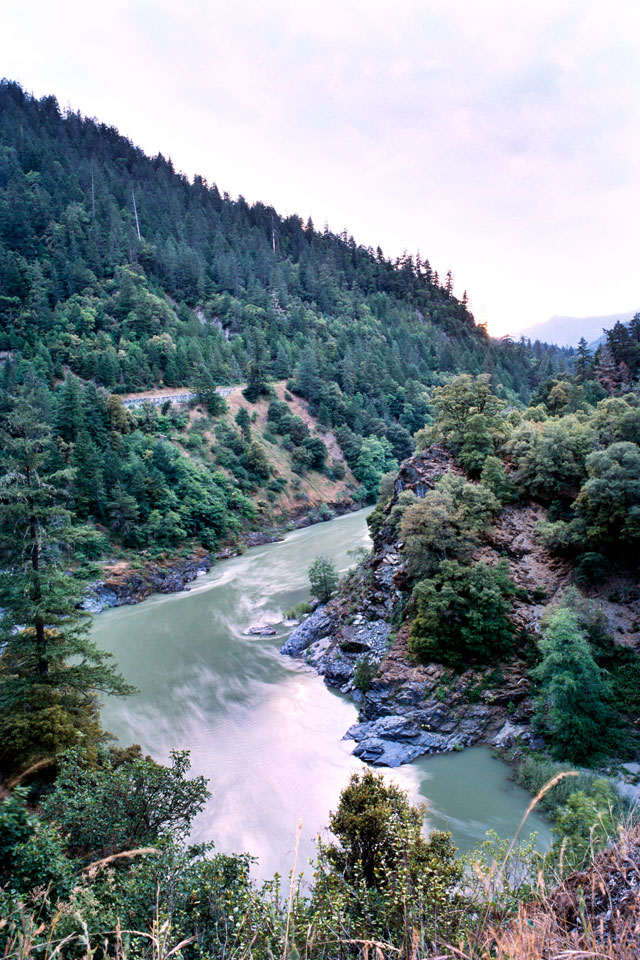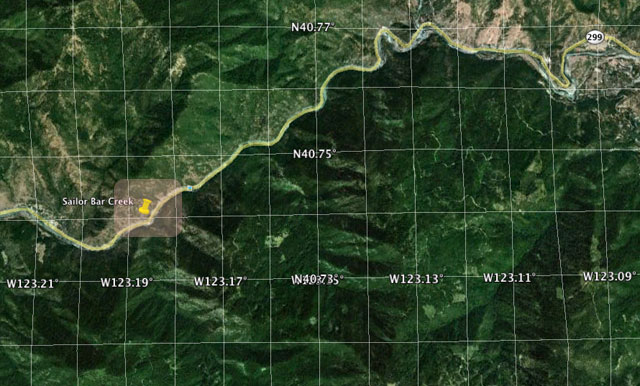
Senior Wesley Korpela, an anthropology major and avid fan of pirates and underwater archaeology, has his very own detective’s tale to tell about the 19th-century site. His original research of the Sailor’s Bar legend has recaptured an era suffused with the lust for gold, the lore of the Wild West and shades of Gilbert and Sullivan’s comic opera, “The Pirates of Penzance.”
Korpela was tipped off late last summer about the Sailor’s Bar saga, which claims that, a la the ‘Penzance’ musical, a band of fugitive British sailors led by one William English made its way to Trinity County in 1842 after burning their ship off Cape Mendocino. The pirates were believed by Trinity and other local historians to have discovered gold at Sailor’s Bar and attempted to mine it.
If the claim were true, it would mean revising the history of California’s famed gold rush, triggered by the discovery in January 1848, of shining flecks of metal in the tailrace of John Sutter’s sawmill on a tributary of the Sacramento River.

As Korpela headed one day in August to the Anthropology Department’s Cultural Resource Facility, he encountered the CRF’s co-director, Bill Rich, who knew of the student’s intense interest in pirates and underwater archaeology. Rich explained that historians around the area had been probing the Sailor’s Bay saga for decades, but kept running into dead ends. A fresh pair of eyes was warranted; if Korpela were interested, he might find something new, perhaps historically significant. One task of HSU’s Cultural Resources Facility, housed in the Behavioral and Social Sciences Building, is heritage preservation.
The challenge excited Korpela, to say the least. The whole point was to prove the legend true or not, once and for all. What he needed most, he recognized, were original sources. He began tracking them down with a will. He went first of course to the Trinity County Historical Society. He proceeded to scavenge old, often spotty California census records. He also spent countless hours combing through old history books in the resource-rich Humboldt Room at the HSU Library.
Like historians before him, Korpela ran into false leads and dead ends galore, including Sailor’s Bar itself. In October, Korpela, Rich, three Trinity historians and 10 volunteer students of the CRF conducted an on-site survey for artifacts or physical traces of settlement by English’s fugitive crew. The results were disappointing. Trash and scrap metal were of post-World War II vintage. “We did find a pick ax and a small animal trap near a tree,” Korpela recalls, “but the trap was dated about the turn of the century, suggesting that the pick ax was probably from about the same time, too.”
A few physical features did provide clues to human activity at Sailor’s Bar. “We saw a ditch on both sides that went along the creek up in the hills, used for hydro-pumping of gold and quartz. Miners would dig ditches along the river or creek and use gravity to increase the speed of the water and squeeze it though a hose to wash off the dirt and expose veins of minerals. We also found two flat spots that suggested that there was possible human settlement.”

At another point along the Trinity River, about 50 meters from Sailor’s Bar, Korpela and his CRF colleagues found apparent miner’s equipment, but it was probably from the turn of the century as well, they surmised. “This is all we found at Sailor’s Bar, and nothing answered any of our questions,” Korpela says.
Undeterred, he hit the history books again. This time, he decided to hunker down on the central question: Just who was William English, anyway? That new focus would save the search.
The Humboldt Room staff had previously advised Korpela to reexamine his notes from time to time, in case he had overlooked some clue or evidence the first time through. He followed that advice and hit ‘Wild West’ pay dirt: ‘William Rice’ may have been the mistaken name of Major William P. Reynolds, the reputed son of a Massachusetts sea captain and a Malay-Chinese mother. Further research indicated Reynolds was born in the Philippines in either 1820 or 1821, owned a ship that crashed near Monterey Bay in 1845 and for a time pursued piracy in some form. Korpela also learned that Reynolds traveled widely in California and enjoyed links with powerful ranchers.
The Asian connection—the Malay-Chinese mother—is a key part of the puzzle. According to the Sailor’s Bar legend, the mis-named Captain English piloted a warship of the British East India Company, went rogue along the Chinese coast, was subsequently pursued by British authorities and fled across the Pacific to Cape Mendocino, where he burned his vessel.
Korpela emphasizes that major questions remain: Did Reynolds arrive in California in or before 1842? Did he ever visit Trinity County? And, if he did, did he and his fellow pirates discover gold at Sailor’s Bar?
Whether Korpela tracks down those answers or not, he appears to be the first researcher to unmask the legendary William English as Major William P. Reynolds.
“There’s at least the potential here to reexamine the discovery of gold in early California history,” says Rich, who, as co-director of the CRF, helps guide the consulting agency’s supply of cultural resources management services to federal, state and local agencies, as well as northwest California tribes. “Where did that history really start, and who started it? Wesley’s hands-on work will help Trinity County historians and U.S. Forest Service archaeologists--Sailor’s Bar is now on Forest Service property.”